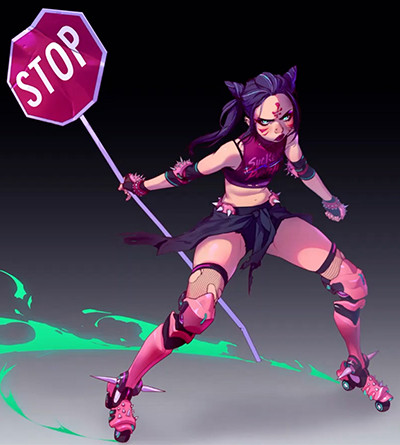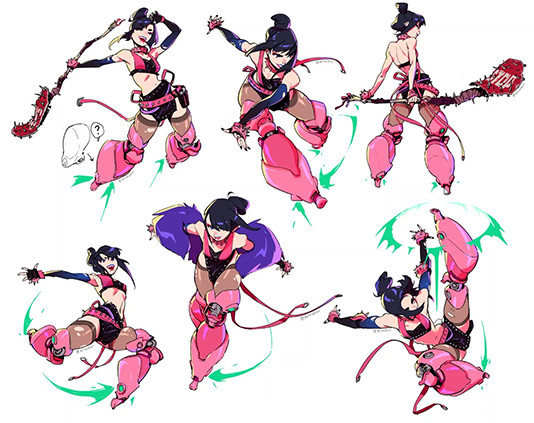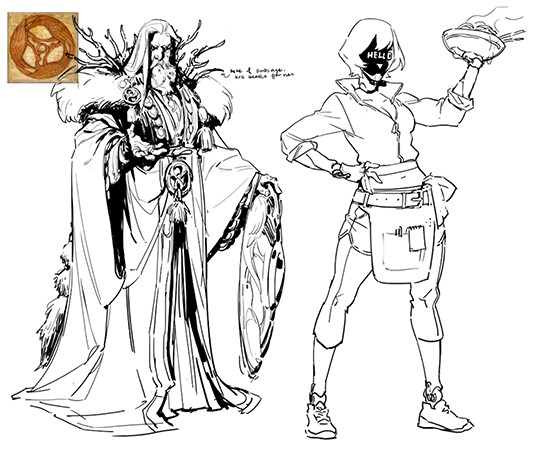Hi everyone! I’m Knight Zhang, and I’m a freelance illustrator and character concept artist. Today I’d like to talk about storytelling through costume design, and offer you three ways to help you develop visually interesting and meaningful characters.
Preface
Before we get started, I'd like to preface with a general statement that this isn’t technically about character design, but is merely a closer look at an aspect of character concept. A good costume design is not defined by its complexity, but its ability to tell the best story for the right character.
My goal with this lesson is not to instruct or instill a step by step process for you to necessarily follow, but rather encourage you to find the magic in delving deeper when it comes to your characters costume design. The way you and I dress are choices we actively make day to day, and as a designer, you have the opportunity to communicate the most important parts of your character’s lore with just the way they dress.
Purpose of Costume Design
Whether simple or complex, the aim of a costume will always be to highlight the key things you need to know about a character, namely their purpose, their personality, and their history. It can help define your character’s archetype, or exemplify their role within a story.
Spectrums of Design
So to get started, one of the first things to consider is how you are defining your design philosophy for this world, which will ultimately influence the style of your character’s costume. Overall, you can think about design like a spectrum. I’ve personally always been a believer that there is no such thing as “bad design”, but merely a design that falls short of its full potential for the person who’s looking at it. Every designer has their own solution for every creative problem, and those differences are what defines the philosophies of a variety of visual aesthetics. For the purposes of this video, I’ll be pitching the following two spectrums: Functional vs. Fantasy, and Historical vs. Fictional.
Functional vs. Fantasy is a way to describe the technical aspects of your character’s design code. Do you lean towards designs which are purely realistic and have logical reasons behind its visual appearance?
Or are you more interested in creating graphically iconic and bombastic designs that have very little functional logic to back it up?

Examples of functional design are games such as Call of Duty and Uncharted, while media with a more fantastical approach may include games like Bayonetta and World of Warcraft and Final Fantasy.
Historical vs. Fictional is a way to describe the visual aspects of your character’s design code. Are your designs grounded in a pre-existing culture or historical period, or is it an amalgamation of different cultural inspirations? Examples of historical design are movies like Dunkirk and Seven Samurai, while fictional designs might include games such as Horizon Zero Dawn, or movies like The Fall (2006).

Most designers will find themselves somewhere between the two extremes of both spectrums, and where you fall will define the baseline for your costume design.
Process of Design
Once you’ve figured out the parameters of your design code, it’s time to start figuring out the basics for your character. Research is a primary first step to any form of design, and is especially crucial if you’re designing something that is predominantly functional or historical. Even if you are planning to work in a fantastical or bizarre aesthetic, research can help push your ideas into new realms of possibility, and challenge you to dive deeper into your character’s worldbuilding.
I want to go through some of my own examples of reference boards and show you how I've done the process. This way you can see a visual example of all of these things I am talking about.
This is for a project I did back in 2019. The first thing I always do I go on pint rest and I basically just make a whole board for the entire project and I make sub-boards within it. This helps me better organize my thoughts. I am trying to nail down a very specific aesthetic and Im not thinking about actually using any of these pictures in the final reference board. Its just looking for images that evoke the right feeling for me.
For this project, I really liked the bubble gum punk esthetic and I wanted to go with something kind of crazy and wild. Obviously if you compare the final image, she doesn't look too much like any of these images but I just wanted to set the tone for her at the start.

If you look at what eventually became my final reference board, this is what I ended up making. For this project in particular, I wanted to have the reference boards really emulate the feeling of the character it self so everything about the text, color pallet, ect. I wanted it to be very evocative of the feeling I was going for.
I have two different divisions and I like doing this because it gives me a concrete way of applying my research. On the left side I have the fashion. So that side is very much real world application of what I am thinking. Maybe a bit of the ensemble or some images that evoke the right feeling for me.
Then the right side is more of the aesthetic part. This is more focused on the kind of feeling it gives me. That is why on this side you can see the delinquents and the biker gangs. But then also different forms of neon, punk, street looking, modern aesthetics.

Once I had that all figured out, I went ahead and started ideating. I made a lot of sketches traditionally that would lead to finding that very specific feel that I was looking for. During this process I was king of all over the place and still trying to figure out the specifics of her character. I settled on a roller derby athlete pretty early on and so a big part of her design was that she had to have rollerblades. Since the IP itself was futuristic, I really wanted her to have fully automated legs along with the big crazy hairstyle, spikes, punk, fishnets. I was was trying to combine all these different things into ideas. There was also the idea that she would combine a weapon to her outfit because the idea for the IP was originally that it was a kind of a capture the flag battle arena. I was also exploring different body types too. Writing is also a very helpful tool to help get all of your ideas down that you might not be able to express with your drawing. This really shows why ideating is such a useful process. It really helps you breakdown all of your concepts and when you put things down on paper it can really grow and develop even further that you imagined.

I really like drawing girls and punk-styles which is probably why she has the most sketches out of anyone in this project. You can see here how I'm just trying out all different types of ideating techniques like silhouettes, line drawings, thumbnails, ect.


This was a sketch that was inspired by a drawing that happened on one of the first pages I had ever worked on for this project and she ended up being the inspiration for the final sketch. I wanted to emphasize this kind of really out there and spunky kind of roller derby athlete. But I also really wanted to emphasize that one of her biggest points is that she was this outspoken skater who was always moving. To show this I gave her these really big legs that are almost like rockets.

I then started to do a lot more poses trying to break down her personality. Just trying to figure out specifically how I want her to pose, how I want her to move, ways to show her personality while she is stationary.


As a side note, it’s important that as designers we have to use our research responsibly. It's crucial that we don't treat these cultures as merely aesthetics, but as key aspects which can mold and explain the various infrastructures within our story. Having strong and genuine reasons behind each design choice you make for a character will not only solidify their design overall, but also push you to find new and interesting ways to implement your research.

The visual aesthetics within a given society are almost always a reflection of their worldview, geological or mythical, and how you apply these elements of design will showcase a true understanding of both your inspirations and the scope of your character’s world.

Ensemble
Now that you have some research to get you started, it’s time to think about the character’s general ensemble. This is literally just about what they are wearing, is it a single layered tunic or piles of armor and fur? The seams on the shirt, types of shoes, hats, jackets, all of these things can help inform the audience on how they choose to present themselves to the outside world.
Regardless of how little or how much they wear, not only does this give the audience a quick read on your character’s personality, their job, and their socioeconomic status, but it also provides an opportunity to think about some of the core principles of character design, such as having a strong silhouette read and interesting shapes. Some things you can think about is having a varied spread of big, medium, and small shapes, and keeping an eye out of opportunities to showcase a character’s unique quirks through an item of clothing. To further the impact of a character’s ensemble is to define the materials of their costume through the use of textiles and surface texture.
Textiles

Additionally, color blocking is also a great way to divide up your character’s costume into shapes that add to the overall visual interest. My general rule of thumb is to use different shades and saturations of one primary color for 40-60% of the character. Secondary parts of the clothing or medium shaped decor are somewhere in a similar hue family (such as deep blues with brighter greens, or warm reds with golds and purple). Opposing pop of color is reserved for accents and smaller details. You can obviously deviate from this but I’ve found this process to be a good jumping off point, especially if you’re someone like me who struggles to envision or pick good color palettes early on.
The availability and accessibility to certain fabrics and dyes can also serve as subtle ways to define a character’s position in life. Historically, access to dyes of a certain exotic or expensive colored material would indicate someone’s wealth and social standing, while the flora and fauna of a geographical region might influence the style of one’s costume. Are certain common animals or plants considered spiritually significant to the point of becoming a communal motif, or perhaps naturally available materials can define the style of a particular region? A real world example of this is the unique manufacturing process for the Oshima Tsumugi, one of Japan’s most high-end kimonos. It’s distinguished for its luminous black color, created through a process of washing the silk through the iron-rich mud found on the island of Oshima. This aspect alone sets it apart from other similarly looking fabrics due to the geographical significance of the material, and other real world applications such as this can serve as inspiration for how you define the cultures behind your character’s costume.

Props
The third and final way to sell a character through their costume is through the props they carry with them. Whether it’s through a weapon, a piece of sentimental jewelry, the overstuffed pack slung over a shoulder, props can show what is so important that a character would actively carry it on them. How little or how much they carry can also indicate where they are in their life or journey.

Barren and devoid of ornamentation? Perhaps they’re at the end of their rope and desperate, or maybe they renounce material things and live life in simplicity. Encumbered by a weighty collection of baubles and items? That could communicate a hoarder with a penchant for overindulgence, or perhaps someone wearing their guilt on their sleeve as penance for a past crime. There are a variety of ways to decorate your character’s costume which can help draw your viewers attention to specific places. Some examples would be a beaded necklaces creating leading lines towards their face, or dividing the empty space on a shirt with a chest holster or cute enamel pins. It can even help define the big, medium, and small shapes we discussed earlier.

The design and make of the prop itself is also something worth considering. Would your character be able to afford a novelty knife made of foreign steel, or are they thrifty enough to DIY a crude but deadly shiv from materials at the bottom of a bag? Do they prefer flashy guns with a custom skin, or are they holding onto a broken and deteriorating sword hilt because of its personal significance? Questions like these can help build lore without needing to directly describe it to an audience, and makes for fun easter eggs if anyone cares to look just a little bit deeper.

Summary of Process
It’s through the exploration of a character’s ensemble, the details in its textiles, and the props they carry that helps designers convey a character’s personality, purpose, and history. Using different levels of complexity within a design is essential to creating a balanced and aesthetically pleasing character.
Final Thoughts
At the end of the day, costume design is merely a tool with which you can expand the lore of a character and their world through visual communication, and it can be really effective in pulling together the worldbuilding while also adding interesting and unique flairs to the character cast. How much or how little you choose to develop an aspect of a character’s costume is up to you, as long as the costume fulfills its purpose of truly conveying your character. And again, it doesn’t have to be this deep! If you’re feeling like a t-shirt and some dirty jeans are more than enough for your character, that’s a perfectly valid costume design!
That’s what’s fun and exciting about costume, and character design in general. Good designs are simply designs that give an audience an accurate and quick read on the character and their purpose in the story. Costumes are just one of the ways you can communicate those ideas. However that manifests itself in your work is as valid as the work of any other designer.

I hope this lesson encourages you to explore costume design as a form of communication in regards building lore within a world by adding context to a story. I know it can be kind of daunting to approach it and it is a very subjective field. But I think that is what makes it interesting. There are so many different possibilities the possibilities and endless different solutions to how you can design a single given character.
If you’re interested in asking me questions or just following my art in general, you can follow me on my Website, Instagram, Twitter, Artstation, or by dropping into my Twitch Chat when I livestream every Friday at 7pm PST! There I answer any questions people have for me about my opinions and advice for art, life, and other things. Or you can just watch me draw stuff for a few hours. Thank you to Proko and his team for inviting me to make this video and giving me the space to talk about something I’m really passionate about. I hope you got something out of this, whether small or big, and I hope it inspires you to dive deeper into the glorious possibilities in costume design.


